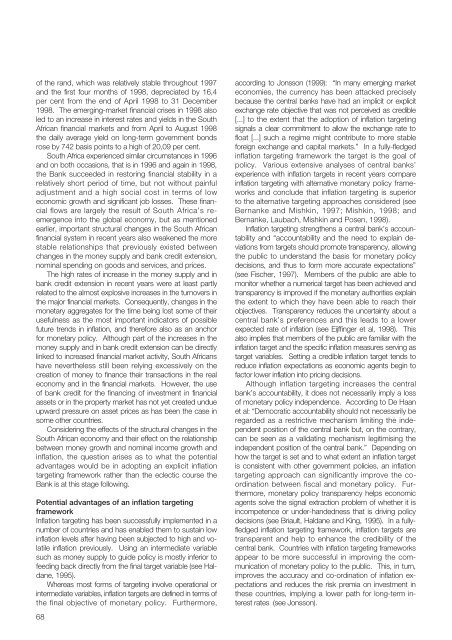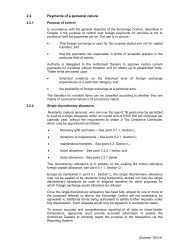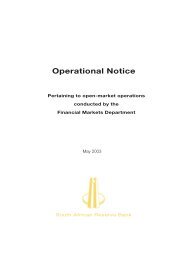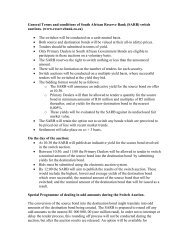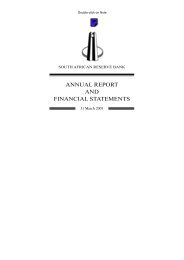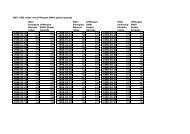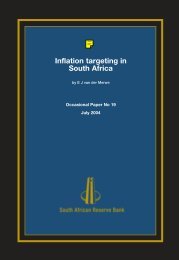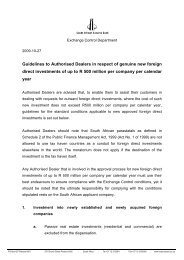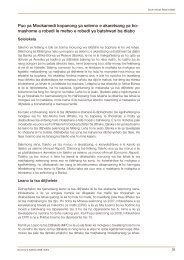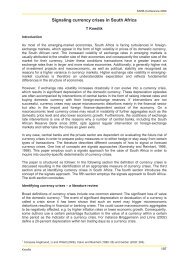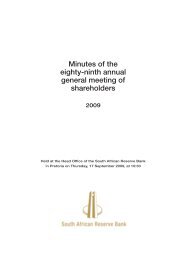Article: Quarterly Bulletin - South African Reserve Bank
Article: Quarterly Bulletin - South African Reserve Bank
Article: Quarterly Bulletin - South African Reserve Bank
Create successful ePaper yourself
Turn your PDF publications into a flip-book with our unique Google optimized e-Paper software.
of the rand, which was relatively stable throughout 1997<br />
and the first four months of 1998, depreciated by 16,4<br />
per cent from the end of April 1998 to 31 December<br />
1998. The emerging-market financial crises in 1998 also<br />
led to an increase in interest rates and yields in the <strong>South</strong><br />
<strong>African</strong> financial markets and from April to August 1998<br />
the daily average yield on long-term government bonds<br />
rose by 742 basis points to a high of 20,09 per cent.<br />
<strong>South</strong> Africa experienced similar circumstances in 1996<br />
and on both occasions, that is in 1996 and again in 1998,<br />
the <strong>Bank</strong> succeeded in restoring financial stability in a<br />
relatively short period of time, but not without painful<br />
adjustment and a high social cost in terms of low<br />
economic growth and significant job losses. These financial<br />
flows are largely the result of <strong>South</strong> Africa’s reemergence<br />
into the global economy, but as mentioned<br />
earlier, important structural changes in the <strong>South</strong> <strong>African</strong><br />
financial system in recent years also weakened the more<br />
stable relationships that previously existed between<br />
changes in the money supply and bank credit extension,<br />
nominal spending on goods and services, and prices.<br />
The high rates of increase in the money supply and in<br />
bank credit extension in recent years were at least partly<br />
related to the almost explosive increases in the turnovers in<br />
the major financial markets. Consequently, changes in the<br />
monetary aggregates for the time being lost some of their<br />
usefulness as the most important indicators of possible<br />
future trends in inflation, and therefore also as an anchor<br />
for monetary policy. Although part of the increases in the<br />
money supply and in bank credit extension can be directly<br />
linked to increased financial market activity, <strong>South</strong> <strong>African</strong>s<br />
have nevertheless still been relying excessively on the<br />
creation of money to finance their transactions in the real<br />
economy and in the financial markets. However, the use<br />
of bank credit for the financing of investment in financial<br />
assets or in the property market has not yet created undue<br />
upward pressure on asset prices as has been the case in<br />
some other countries.<br />
Considering the effects of the structural changes in the<br />
<strong>South</strong> <strong>African</strong> economy and their effect on the relationship<br />
between money growth and nominal income growth and<br />
inflation, the question arises as to what the potential<br />
advantages would be in adopting an explicit inflation<br />
targeting framework rather than the eclectic course the<br />
<strong>Bank</strong> is at this stage following.<br />
Potential advantages of an inflation targeting<br />
framework<br />
Inflation targeting has been successfully implemented in a<br />
number of countries and has enabled them to sustain low<br />
inflation levels after having been subjected to high and volatile<br />
inflation previously. Using an intermediate variable<br />
such as money supply to guide policy is mostly inferior to<br />
feeding back directly from the final target variable (see Haldane,<br />
1995).<br />
Whereas most forms of targeting involve operational or<br />
intermediate variables, inflation targets are defined in terms of<br />
the final objective of monetary policy. Furthermore,<br />
68<br />
according to Jonsson (1999): “In many emerging market<br />
economies, the currency has been attacked precisely<br />
because the central banks have had an implicit or explicit<br />
exchange rate objective that was not perceived as credible<br />
[...] to the extent that the adoption of inflation targeting<br />
signals a clear commitment to allow the exchange rate to<br />
float [...] such a regime might contribute to more stable<br />
foreign exchange and capital markets.” In a fully-fledged<br />
inflation targeting framework the target is the goal of<br />
policy. Various extensive analyses of central banks’<br />
experience with inflation targets in recent years compare<br />
inflation targeting with alternative monetary policy frameworks<br />
and conclude that inflation targeting is superior<br />
to the alternative targeting approaches considered (see<br />
Bernanke and Mishkin, 1997; Mishkin, 1998; and<br />
Bernanke, Laubach, Mishkin and Posen, 1998).<br />
Inflation targeting strengthens a central bank’s accountability<br />
and “accountability and the need to explain deviations<br />
from targets should promote transparency, allowing<br />
the public to understand the basis for monetary policy<br />
decisions, and thus to form more accurate expectations”<br />
(see Fischer, 1997). Members of the public are able to<br />
monitor whether a numerical target has been achieved and<br />
transparency is improved if the monetary authorities explain<br />
the extent to which they have been able to reach their<br />
objectives. Transparency reduces the uncertainty about a<br />
central bank’s preferences and this leads to a lower<br />
expected rate of inflation (see Eijffinger et al, 1998). This<br />
also implies that members of the public are familiar with the<br />
inflation target and the specific inflation measures serving as<br />
target variables. Setting a credible inflation target tends to<br />
reduce inflation expectations as economic agents begin to<br />
factor lower inflation into pricing decisions.<br />
Although inflation targeting increases the central<br />
bank’s accountability, it does not necessarily imply a loss<br />
of monetary policy independence. According to De Haan<br />
et al: “Democratic accountability should not necessarily be<br />
regarded as a restrictive mechanism limiting the independent<br />
position of the central bank but, on the contrary,<br />
can be seen as a validating mechanism legitimising the<br />
independent position of the central bank.” Depending on<br />
how the target is set and to what extent an inflation target<br />
is consistent with other government policies, an inflation<br />
targeting approach can significantly improve the coordination<br />
between fiscal and monetary policy. Furthermore,<br />
monetary policy transparency helps economic<br />
agents solve the signal extraction problem of whether it is<br />
incompetence or under-handedness that is driving policy<br />
decisions (see Briault, Haldane and King, 1995). In a fullyfledged<br />
inflation targeting framework, inflation targets are<br />
transparent and help to enhance the credibility of the<br />
central bank. Countries with inflation targeting frameworks<br />
appear to be more successful in improving the communication<br />
of monetary policy to the public. This, in turn,<br />
improves the accuracy and co-ordination of inflation expectations<br />
and reduces the risk premia on investment in<br />
these countries, implying a lower path for long-term interest<br />
rates (see Jonsson).


